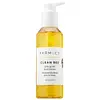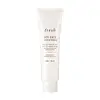What's inside
What's inside
 Key Ingredients
Key Ingredients

 Benefits
Benefits

 Concerns
Concerns

 Ingredients Side-by-side
Ingredients Side-by-side

Water
Skin ConditioningSodium Lauroyl Methyl Isethionate
CleansingCocamidopropyl Hydroxysultaine
CleansingChamomilla Recutita Flower Water
MaskingDecyl Glucoside
CleansingMaltooligosyl Glucoside
Skin ConditioningLauryl Glucoside
CleansingGlycerin
HumectantHydrogenated Starch Hydrolysate
HumectantEchinacea Purpurea Root Extract
MoisturisingHoney Extract
HumectantPropolis Extract
Skin ConditioningRoyal Jelly Extract
Skin ConditioningHydrolyzed Sodium Hyaluronate
Skin ConditioningCalendula Officinalis Flower Extract
MaskingGlycyrrhiza Glabra Root Extract
BleachingAloe Barbadensis Leaf Juice
Skin ConditioningMelia Azadirachta Leaf Extract
Skin ConditioningLavandula Angustifolia Oil
MaskingLavandula Hybrida Oil
EmollientCurcumin
AntioxidantCurcuma Longa Root Extract
MaskingBetaine
HumectantSodium PCA
HumectantDisodium Cocoyl Glutamate
CleansingSodium Cocoyl Glutamate
CleansingCitric Acid
BufferingSodium Benzoate
MaskingAbies Sibirica Oil
MaskingCymbopogon Martini Oil
MaskingPelargonium Graveolens Oil
MaskingPogostemon Cablin Leaf Oil
MaskingCaramel
Cosmetic ColorantAnthemis Nobilis Flower Oil
MaskingOcimum Basilicum Flower/Leaf Extract
TonicOcimum Sanctum Leaf Extract
Skin ConditioningMelia Azadirachta Flower Extract
Skin ConditioningCorallina Officinalis Extract
Skin ConditioningAroma
Potassium Sorbate
PreservativeMaltodextrin
AbsorbentTrisodium Ethylenediamine Disuccinate
Sodium Chloride
MaskingSodium Phytate
Propanediol
SolventLinalool
PerfumingWater, Sodium Lauroyl Methyl Isethionate, Cocamidopropyl Hydroxysultaine, Chamomilla Recutita Flower Water, Decyl Glucoside, Maltooligosyl Glucoside, Lauryl Glucoside, Glycerin, Hydrogenated Starch Hydrolysate, Echinacea Purpurea Root Extract, Honey Extract, Propolis Extract, Royal Jelly Extract, Hydrolyzed Sodium Hyaluronate, Calendula Officinalis Flower Extract, Glycyrrhiza Glabra Root Extract, Aloe Barbadensis Leaf Juice, Melia Azadirachta Leaf Extract, Lavandula Angustifolia Oil, Lavandula Hybrida Oil, Curcumin, Curcuma Longa Root Extract, Betaine, Sodium PCA, Disodium Cocoyl Glutamate, Sodium Cocoyl Glutamate, Citric Acid, Sodium Benzoate, Abies Sibirica Oil, Cymbopogon Martini Oil, Pelargonium Graveolens Oil, Pogostemon Cablin Leaf Oil, Caramel, Anthemis Nobilis Flower Oil, Ocimum Basilicum Flower/Leaf Extract, Ocimum Sanctum Leaf Extract, Melia Azadirachta Flower Extract, Corallina Officinalis Extract, Aroma, Potassium Sorbate, Maltodextrin, Trisodium Ethylenediamine Disuccinate, Sodium Chloride, Sodium Phytate, Propanediol, Linalool
Water
Skin ConditioningCoco-Glucoside
CleansingButylene Glycol
HumectantGlycerin
HumectantPropanediol
SolventXanthan Gum
Emulsifying1,2-Hexanediol
Skin ConditioningPolyglyceryl-10 Laurate
Skin ConditioningCentaurea Cyanus Flower Water
Skin ConditioningCucumis Sativus Fruit Extract
EmollientHelianthus Annuus Seed Oil
EmollientBorago Officinalis Seed Oil
EmollientHydrolyzed Soy Protein
HumectantRosa Damascena Extract
MaskingRosa Damascena Flower Water
MaskingAloe Barbadensis Leaf Juice
Skin ConditioningPanax Ginseng Root Extract
EmollientMalva Sylvestris Flower Extract
Skin ConditioningRosa Damascena Flower Oil
MaskingTocopherol
AntioxidantCaprylic/Capric Triglyceride
MaskingCaprylyl Glycol
EmollientHydrolyzed Jojoba Esters
Skin ConditioningSilica
AbrasiveCitric Acid
BufferingPentylene Glycol
Skin ConditioningCaramel
Cosmetic ColorantSodium Hydroxide
BufferingSodium Benzoate
MaskingPotassium Sorbate
PreservativeWater, Coco-Glucoside, Butylene Glycol, Glycerin, Propanediol, Xanthan Gum, 1,2-Hexanediol, Polyglyceryl-10 Laurate, Centaurea Cyanus Flower Water, Cucumis Sativus Fruit Extract, Helianthus Annuus Seed Oil, Borago Officinalis Seed Oil, Hydrolyzed Soy Protein, Rosa Damascena Extract, Rosa Damascena Flower Water, Aloe Barbadensis Leaf Juice, Panax Ginseng Root Extract, Malva Sylvestris Flower Extract, Rosa Damascena Flower Oil, Tocopherol, Caprylic/Capric Triglyceride, Caprylyl Glycol, Hydrolyzed Jojoba Esters, Silica, Citric Acid, Pentylene Glycol, Caramel, Sodium Hydroxide, Sodium Benzoate, Potassium Sorbate
 Reviews
Reviews

Ingredients Explained
These ingredients are found in both products.
Ingredients higher up in an ingredient list are typically present in a larger amount.
Aloe Barbadensis Leaf Juice comes from leaves of the aloe plant. Aloe Barbadensis Leaf Juice is best known for helping to soothe sunburns. It is also anti-inflammatory, moisturizing, antiseptic, and can help heal wounds.
Aloe is packed with good stuff including Vitamins A, C, and E. These vitamins are antioxidants, which help fight free-radicals and the damage they may cause. Free-radicals are molecules that may damage your skin cells, such as pollution.
Aloe Barbadensis Leaf Juice also contains sugars. These sugars come in the form of monosaccharides and polysaccharides, folic acid, and choline. These sugars are able to help bind moisture to skin.
It also contains minerals such as calcium, 12 anthraquinones, fatty acids, amino acids, and Vitamin B12.
Learn more about Aloe Barbadensis Leaf JuiceWe don't have a description for Caramel yet.
Citric Acid is an alpha hydroxy acid (AHA) naturally found in citrus fruits like oranges, lemons, and limes.
Like other AHAs, citric acid can exfoliate skin by breaking down the bonds that hold dead skin cells together. This helps reveal smoother and brighter skin underneath.
However, this exfoliating effect only happens at high concentrations (20%) which can be hard to find in cosmetic products.
Due to this, citric acid is usually included in small amounts as a pH adjuster. This helps keep products slightly more acidic and compatible with skin's natural pH.
In skincare formulas, citric acid can:
While it can provide some skin benefits, research shows lactic acid and glycolic acid are generally more effective and less irritating exfoliants.
Most citric acid used in skincare today is made by fermenting sugars (usually from molasses). This synthetic version is identical to the natural citrus form but easier to stabilize and use in formulations.
Read more about some other popular AHA's here:
Learn more about Citric AcidGlycerin is already naturally found in your skin. It helps moisturize and protect your skin.
A study from 2016 found glycerin to be more effective as a humectant than AHAs and hyaluronic acid.
As a humectant, it helps the skin stay hydrated by pulling moisture to your skin. The low molecular weight of glycerin allows it to pull moisture into the deeper layers of your skin.
Hydrated skin improves your skin barrier; Your skin barrier helps protect against irritants and bacteria.
Glycerin has also been found to have antimicrobial and antiviral properties. Due to these properties, glycerin is often used in wound and burn treatments.
In cosmetics, glycerin is usually derived from plants such as soybean or palm. However, it can also be sourced from animals, such as tallow or animal fat.
This ingredient is organic, colorless, odorless, and non-toxic.
Glycerin is the name for this ingredient in American English. British English uses Glycerol/Glycerine.
Learn more about GlycerinPotassium Sorbate is a preservative used to prevent yeast and mold in products. It is commonly found in both cosmetic and food products.
This ingredient comes from potassium salt derived from sorbic acid. Sorbic acid is a natural antibiotic and effective against fungus.
Both potassium sorbate and sorbic acid can be found in baked goods, cheeses, dried meats, dried fruit, ice cream, pickles, wine, yogurt, and more.
You'll often find this ingredient used with other preservatives.
Learn more about Potassium SorbatePropanediol is an all-star ingredient. It softens, hydrates, and smooths the skin.
It’s often used to:
Propanediol is not likely to cause sensitivity and considered safe to use. It is derived from corn or petroleum with a clear color and no scent.
Learn more about PropanediolSodium Benzoate is a preservative. It's used in both cosmetic and food products to inhibit the growth of mold and bacteria. It is typically produced synthetically.
Both the US FDA and EU Health Committee have approved the use of sodium benzoate. In the US, levels of 0.1% (of the total product) are allowed.
Sodium benzoate works as a preservative by inhibiting the growth of bacteria inside of cells. It prevents the cell from fermenting a type of sugar using an enzyme called phosphofructokinase.
It is the salt of benzoic acid. Foods containing sodium benzoate include soda, salad dressings, condiments, fruit juices, wines, and snack foods.
Studies for using ascorbic acid and sodium benzoate in cosmetics are lacking, especially in skincare routines with multiple steps.
We always recommend speaking with a professional, such as a dermatologist, if you have any concerns.
Learn more about Sodium BenzoateWater. It's the most common cosmetic ingredient of all. You'll usually see it at the top of ingredient lists, meaning that it makes up the largest part of the product.
So why is it so popular? Water most often acts as a solvent - this means that it helps dissolve other ingredients into the formulation.
You'll also recognize water as that liquid we all need to stay alive. If you see this, drink a glass of water. Stay hydrated!
Learn more about Water